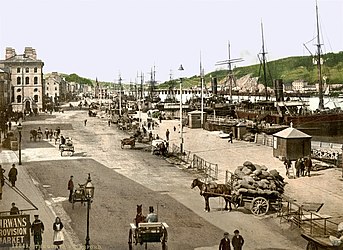Wikipedia:Picture of the day/January 2010: Difference between revisions
m robot Removing: yo:Wikipedia:Picture of the day/January 2010 |
mNo edit summary |
||
| Line 39: | Line 39: | ||
[[Category:Wikipedia Picture of the day January 2010]] |
[[Category:Wikipedia Picture of the day January 2010]] |
||
</noinclude> |
</noinclude> |
||
[[es:Wikipedia:Imagen del día/enero de 2010]] |
|||
[[tr:Vikipedi:Günün seçkin resmi/Ocak 2010]] |
|||
[[zh-yue:Wikipedia:是日靚畫/2010年1月]] |
|||
Latest revision as of 07:28, 13 December 2014
|
Featured picture tools: |
These featured pictures, as scheduled below, appeared as the picture of the day (POTD) on the English Wikipedia's Main Page in January 2010. Individual sections for each day on this page can be linked to with the day number as the anchor name (e.g. [[Wikipedia:Picture of the day/January 2010#1]] for January 1).
You can add an automatically updating POTD template to your user page using {{Pic of the day}} (version with blurb) or {{POTD}} (version without blurb). For instructions on how to make custom POTD layouts, see Wikipedia:Picture of the day.
January 1

|
A 1639 watercolor painting of Havana Harbor, Cuba. The recorded history of Cuba dates to 1492, with the arrival of Christopher Columbus on his first voyage to the Americas. Prior to that, the island had been inhabited by the Guanajatabey, Ciboney and Taíno peoples. By 1514, the Spanish had founded a settlement that eventually became Havana. Artist: Joan Vinckeboons; Restoration: Lise Broer
Recently featured:
|
January 2

|
Upper Wentworth Falls in the Blue Mountains of New South Wales, Australia. The 187-metre (614 ft) three-tiered seasonal waterfall is fed by Kedumba Creek and is the namesake of the nearby town of Wentworth Falls. Near the falls, there is a rocky knoll that has a large number of grinding grooves created by rubbing stone implements on the rock to shape and sharpen them. These marks have been determined to be signs of early human habitation nearby. Photo credit: David Iliff
Recently featured:
|
January 3

|
|
A whole apricot fruit and the cross-section of a second one. The apricot tree has been cultivated since prehistoric times. The scientific name Prunus armeniaca derives from the original assumption that the tree is native to Armenia, but more recent scholarship places the origin in China or India. Today the cultivars are grown worldwide. Photo credit: Fir0002
Recently featured:
|
January 4

|
The Pacific Gull (Larus pacificus) is a very large (58–66 cm (23–26 in) in length) gull native to the coasts of Australia. It is less common than the Silver Gull, and its numbers have been declining in some parts due to competition from the Kelp Gull. Pacific Gulls are usually seen alone or in pairs. Photo credit: Noodle snacks
Recently featured:
|
January 5

|
The umber-brown puffball (Lycoperdon umbrinum) is a puffball mushroom ranging from 2 to 5 cm (0.8 to 2.0 in) tall and 1 to 4 cm (0.4 to 1.6 in) broad. It has a fruiting body that is shaped like a top or a pear, with a short, partly buried stipe. Photo credit: Michael Maggs
Recently featured:
|
January 6

|
A chiaroscuro woodcut of Mary and the infant Jesus. Christians believe that she conceived her son miraculously by the agency of the Holy Spirit. This took place when she was already the betrothed wife of Joseph and was awaiting the concluding rite of Jewish marriage, the formal home-taking ceremony. A number of important doctrines concerning Mary are held by Catholic churches. Primary among these is that as mother of Jesus, Mary became Theotokos, literally the "God-bearer", or "Mother of God". Artist: Bartolommeo Coriolano; Restoration: Lise Broer
Recently featured:
|
January 7

|
Two mating wasps of the subfamily Cremastinae. Species classified in this subfamily are parasitoids of Lepidoptera and Coleoptera larvae in tunnels, leaf rolls, buds and galls. Photo credit: Muhammad Mahdi Karim
Recently featured:
|
January 8

|
An 1868 photo of an Argentine gaucho. The term "gaucho" is used to describe residents of the South American pampas, chacos or Patagonian grasslands, found principally in parts of Argentina, Uruguay, Southern Chile and Southern Region, Brazil. It is a loose equivalent to the North American "cowboy" and often connotes the 19th century more than the present day. In those days, gauchos made up the majority of the rural population, herding cows on the vast estancias, and practicing hunting as their main economic activities. Photo: Courret Hermanos; Restoration: Lise Broer
Recently featured:
|
January 9

|
The InterContinental Amstel Amsterdam is a five-star hotel in Amsterdam, Netherlands, on the east bank of the river Amstel. It opened in 1867 and was the first Grand Hotel in the country. The hotel underwent significant renovations in 1992 at a cost of 70 million guilders. Photo credit: Massimo Catarinella
Recently featured:
|
January 10

|
MS Majesty of the Seas is a Sovereign class cruise ship owned and operated by Royal Caribbean International, a cruise line based in Miami, Florida. Her sister ship MS Sovereign of the Seas was the largest cruise ship in the world at the time of its completion in 1988. Photo credit: UpstateNYer
Recently featured:
|
January 11

|
Crocoite is a mineral consisting of lead(II) chromate and crystallizing in a monoclinic crystal system, and it is the only chromate of any importance found in nature. This specimen comes from Dundas, Tasmania. Crocoite is the official mineral emblem of Tasmania. Photo credit: Noodle snacks
Recently featured:
|
January 12

|
An illustration of relative astronomical orders of magnitude, starting with the terrestrial planets of the Solar System in image 1 (top left) and ending with the largest known star, VY Canis Majoris, at the bottom right. The biggest celestial body in each image is shown on the left of the next frame. Image credit: Dave Jarvis
Recently featured:
|
January 13

|
The Light-mantled Albatross (Phoebetria palpebrata) is a small (length of 79–89 cm or 31.1–35.0 in) sooty-brown or blackish albatross, with markings similar to a Siamese cat. It has a circumpolar pelagic distribution in the Southern Ocean. Except when breeding, its habitat is entirely marine, and it will forage from the edges of the Antarctic drift ice to about 40° S. Photo credit: Vincent Legendre
Recently featured:
|
January 14

|
An 1890s photochrom of the quay at Waterford, Ireland. Founded in 914 at the mouth of the River Suir by the Vikings, it is the country's (and island's) oldest city. Throughout much of Ireland's history, Waterford was second in importance only to Dublin. Today, the city is synonymous with Waterford Crystal. Photochrom: Detroit Publishing Co.; Restoration: Jake Wartenberg
Recently featured:
|
January 15

|
Peter Levy (b. 1955) is a British television and radio presenter, currently host of the BBC regional news programme Look North, broadcast from Hull to East Yorkshire and Lincolnshire. He also hosts The Peter Levy Show on BBC Radio Humberside. Born in South West England, Levy moved to Yorkshire in his teens. After a stint in London as an actor, during which time he appeared on Man About the House, he returned to Yorkshire in 1975 to become a disc jockey before joining Look North in 1987. Photo credit: John Byford
Recently featured:
|
January 16

|
Castle Geyser, a cone geyser in the Upper Geyser Basin of Yellowstone National Park, located in the U.S. states of Wyoming and Montana. It has a 10–12 hour eruption cycle, consisting of hot water spewing up to a height of 90 feet (27 m) for about twenty minutes, followed by a noisy steam phase (shown here) for 30–40 minutes. Photo credit: Mila Zinkova
Recently featured:
|
January 17

|
A female Chrysopilus species of snipe fly, a family of true flies that are found throughout Europe, North America, and Japan. They have slender bodies and stilt-like legs. The mouthparts are adapted for piercing and many species are haematophagous as adults, while others are predatory on other insects. Photo credit: Muhammad Mahdi Karim
Recently featured:
|
January 18

|
Onna yu ("Bathhouse Women"), a late-eighteenth century Japanese woodblock print in the ukiyo-e style, depicting women at a sentō, or Japanese public bath house. Commercial bath houses in Japan date to at least 1266 and became especially popular immediately after World War II, due to the devastation caused by the war. Artist: Torii Kiyonaga; Restoration: Torsodog
Recently featured:
|
January 19

|
Two anemone stinkhorns (Aseroe rubra), a widespread saprotroph fungus recognised by its foul odour of carrion and shape resembling a sea anemone when mature. The fungus attracts flies, which spread its spores. It is found on decomposing plant matter, also on woodchips and mulch and is common in gardens, alpine grasslands and woodlands. Photo credit: Mike Young
Recently featured:
|
January 20

|
A late nineteenth century photo of snake charmers in Tangier, Morocco. Snake charming is the practice of apparently hypnotising a snake, and the performance may use musical instruments and other street performance techniques. The practice as it exists today probably arose in India, where it remains widely practiced, and spread throughout Southeast Asia, the Middle East, and North Africa. Photo: Tancrède Dumas; Restoration: Lise Broer
Recently featured:
|
January 21

|
An 1856 lithograph of the Selimiye Barracks, located in Istanbul, Turkey, being used as a hospital during the Crimean War. Florence Nightingale's experiences here during this time helped her develop the foundations of modern nursing. As such, the barracks now contain a museum dedicated to her and her staff. Lithography: Day & Son; Restoration: Jake Wartenberg
Recently featured:
|
January 22

|
A lithographed poster from 1900 advertising the "Gaiety Dancers" of Rice & Barton's Big Gaiety Spectacular Extravaganza Company. Depicted here is a chorus line, a group of dancers who together perform synchronized routines, usually in musical theatre. Perhaps the most famous chorus line today is The Rockettes. Lithography: The Courier Company; Restoration: Adam Cuerden
Recently featured:
|
January 23

|
The Black Phoebe (Sayornis nigricans) is a distinctive tyrant flycatcher native to western North America, ranging from southwestern Oregon and California to west Texas and northern Mexico. In South America, it can be found in the Andes mountain region, ranging from Colombia in the north, south to northern Argentina. The Black Phoebe reaches a length of 5.75 in (14.6 cm), and unlike other phoebes, has highly contrasting plumage, dark brown or black on most of the body, with white on the underbelly and under the wings. Photo credit: Matthew Field
Recently featured:
|
January 24

|
NGC 5866, known as the Spindle Galaxy, is a lenticular galaxy in the constellation Draco. From Earth, the galaxy can only be seen edge-on, revealing its unusual dust disk. In most lenticular galaxies, cosmic dust is generally found only near the nucleus and generally follows the light profile of the galaxies' bulges. It is also possible that NGC 5866 is a spiral galaxy that was misclassified as a lenticular galaxy because of its edge-on orientation, in which case the dust disk would not be too unusual. Photo credit: NASA, ESA, STScI/AURA
Recently featured:
|
January 25

|
A colored scanning electron microscope image of a rust mite (Aceria anthocoptes), a member of the Aceria genus of mites that are parasites of plants. This can be put to human advantage, as this species in particular is used for biological control of the invasive weed Canada Thistle. Image credit: Erbe & Pooley, ARS
Recently featured:
|
January 26

|
The Sydney Opera House, in Sydney, New South Wales, Australia, at night, as viewed from the Sydney Harbour Bridge pedestrian walkway. One of the most famous buildings in the world, the Opera House was named a UNESCO World Heritage Site in 2007. Photo credit: David Iliff
Recently featured:
|
January 27

|
Plate I of Henry Holiday's original illustrations for the first edition of Lewis Carroll's The Hunting of the Snark, a nonsense poem written in 1874 that tells the story of ten individuals who cross the ocean to hunt the Snark. In common with other Carroll works, the meaning of the poem has been queried and analysed in depth. It is divided into eight "fits" (a pun on the archaic fitt meaning a part of a song, and fit meaning a convulsion) and is by far Carroll's longest poem. Restoration: Adam Cuerden
Recently featured:
|
January 28

|
One of the two earliest illustrations of Jane Austen's novel Pride and Prejudice, which was first published on January 28, 1813. This engraving comes from the first illustrated edition, published twenty years later, and depicts Elizabeth Bennet (the main protagonist, right) and her father, in fashions that were common in the 1830s, not the story's original time setting. The novel is told from Bennet's point of view and deals with issues of manners, upbringing, moral rightness, education and marriage in the aristocratic society of early 19th century England. The novel retains a fascination for modern readers, having sold some 20 million copies worldwide and continuing near the top of lists of 'most loved books'. Artist: George Pickering, Engraver: William Greatbatch; Restoration: Adam Cuerden
Recently featured:
|
January 29

|
The citrus swallowtail (Papilio demodocus) is a large swallowtail butterfly common to sub-Saharan Africa. It is considered a pest species, as the caterpillar feeds on citrus tree leaves. Adults, as seen here, have black and yellow markings with red and blue eyespots. Photo credit: Muhammad Mahdi Karim
Recently featured:
|
January 30

|
|
Bartholomeus van der Helst's 1648 painting depicting a company of schutterij celebrating the Peace of Münster, the treaty between the Dutch Republic and Spain signed earlier that year making the United Netherlands independent from the Holy Roman Empire. The Dutch Revolt had begun in 1566, and the Northern Netherlands became de facto independent over the years. By the end, France allied itself with the Dutch, taking much of the Southern Netherlands. On January 30, 1648, the warring parties reached an agreement after seven years of negotiations, and the final treaty was signed on May 15.
Recently featured:
|
January 31

|
Lady Barron Falls is a cascading waterfall located within a few kilometres of Russell Falls in Mount Field National Park, the oldest national park in Tasmania (Australia), located 64 kilometres (40 mi) northwest of Hobart. Photo credit: Noodle snacks |
Picture of the day archives and future dates
